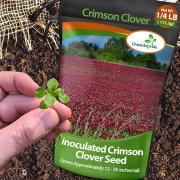Are you convinced that this would be helpful in your own gardening routine? Well, if not, here’s just a few of the benefits of growing a cover crop:
Suppressing weeds – Quick growth of the cover crop can shade out and rob weeds of their nutrients. Good selections for weed suppression would be: rye grass, hairy vetch, oats and buckwheat. Some of these cover crops, notably rye, put out chemicals in the soil, which can interfere with weed seed germination. This process is called allelopathy.
These peas have a vine-like growth that can reach lengths of 3 to 5 feet when planted in fertile soil. Winter peas are highly nutritious and extremely digestible to deer. They carry a protein level between 20 and 30 percent. Both the seed, stem and leaves are browsed by deer. Foliage color is a pale green, and the plant produces pink blooms. Austrian winter peas have moderate drought tolerance but have good winter hardiness.
Erosion control – By growing cover crops with broad leaves to intercept rain and vigorous root systems to hold soil in place, the soil can be protected from winter rains and run-off. Good erosion control covers are annual rye grass, Berseem clover, sweet clovers, and rapeseed.
Improving soil – Poor soil structure can be improved by selecting cover crops that produce large amounts of biomass. This green manure can then be implemented into the soil, adding organic matter which will improve soil aggregation. Growing a cover that has deep roots that swell during growth, like Daikon radish, will help alleviate compaction of soil and break hardpan. Daikon radish is known as a "bio-drill."
Also, growing legumes gives the added benefit of nitrogen fixation. Hairy vetch, crimson clover, and field peas are great examples of nitrogen fixers. Nitrogen can also be held in the soil and kept from leaching out during the heavy rains of winter. These are called cover crops scavengers because they hold the excess nitrogen and other nutrients in the soil root zone so that they will be available for subsequent crops. Examples of scavengers are turnips, radish, and small grains.
Pest management – Some cover crops have been shown to support beneficial soil microbes and produce helpful compounds. Growing a cover crop produces food for beneficial nematodes that play a huge role in the soil ecosystem. Cover crops can also help control unwanted plant-parasitic nematodes that damage crop production. An example would be white mustard with its high amounts of glucosinolate, which can be toxic and help control the populations of damaging nematodes.
On the flip side, cover crops can also be grown to attract pollinators. Buckwheat and phacelia are great annual covers that will increase fruit set for vegetables like squash and tomatoes. They also serve as a secondary food source for beneficial insects that prey on pests.
Are you convinced now? There are so many reasons to grow a cover crop! With some thought and planning, a sustainable, natural management system can be utilized in any garden space.















































